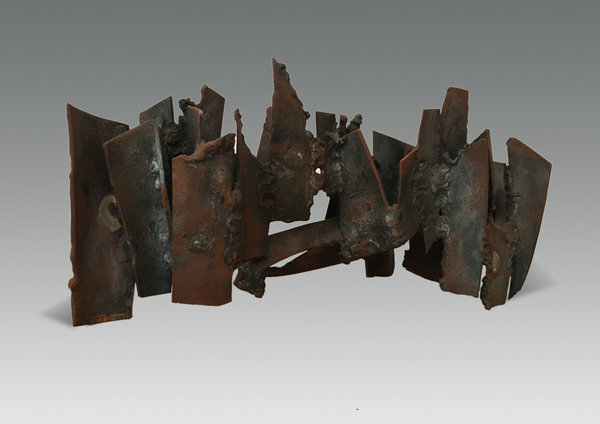Yang Zhenning (second from right) and his wife Weng Fan receive a donation certificate from Luo Shugang (second from left), Minister of Culture, and Wu Weishan, director of the National Art Museum of China. (Photo provided to China Daily)
Yang Zhenning (Chen-Ning Franklin Yang), 94, and Xiong Bingming (Ping-Ming Hsiung, 1922-2002) knew each other since they were 7 years old.
Both their fathers were prominent mathematicians and professors at Tsinghua University in Beijing. The two families were neighbors for eight years.
The boys went to same elementary and secondary schools and stuck together all the time. They both graduated from National Southwestern Associated University in Kunming, Southwest China's Yunnan province, in the 1940s.
Yang later went to the United States, and the physicist became the first Chinese to win a Nobel Prize in 1957. Xiong pursued PhD studies in philosophy in France in 1947, but a year later, he transferred to study sculpture and became a Paris-based artist.
Although living on different continents, the two maintained a long friendship. Xiong gave many of his sculptures to Yang, among which there is one bronze piece, Penholder, specially made for Yang in the late 1950s and bearing both their initials on the back.
On Friday, Yang and his wife Weng Fan donated the sculpture to the National Art Museum of China in Beijing, where Xiong held a retrospective exhibition in 1999. He also donated another two of Xiong's bronze works, Horse and Camel, both produced in the late 1950s.

The three works demonstrate Xiong's distinguished approach to sculpture. He fragmented iron or bronze sheets into smaller pieces, and welded them into forms. The complete works have various enclosures formed by these chips, which according to Yang, become a feature of Xiong's output.
Yang says the approach was popular among artists in Britain and France in the 1950s and Xiong was a pioneer of the development.
"Xiong was an achiever in philosophy and art. He was also a calligrapher. His research in Chinese art infuses his great attainment in both Chinese and Western cultures," Yang said at the donation ceremony.
Xiong's interest in sculpture was ignited after meeting French sculptor Marcel Gimond shortly after he arrived in Paris. He was impressed by Gimond's works and began studying art with him.
Xiong entered the prestigious National School of Fine Arts in Paris in 1950. He taught at the University of Paris beginning in the mid-1960s until he retired in 1989. During the time he also drew, painted, sculpted and practiced calligraphy. He published several books, introducing Chinese art from a Western perspective.
He visited the Chinese mainland many times from the late 1970s, giving lectures and exhibiting. He also left some creations here, including Ru Zi Niu, a cow sculpture that kneels on its forelegs and raises its head high. Xiong crafted it in the 1980s with the assistance of Wu Weishan, now the director of NAMOC and then a young sculptor.
In Chinese, "ruziniu" means a person serving the people wholeheartedly and unselfishly. Yang once said the sculpture summarizes "a whole generation of China's intellectuals of the 20th century". It is installed in the campus of Nanjing University, in East China's Jiangsu province.
In 1998, Xiong was commissioned to sculpt a head of Lu Xun (1881-1936), the famed author and translator, by the Beijing-based National Museum of Modern Chinese Literature. Yang says that in the work, Xiong gave a full expression of the literary figure's honesty and uprightness.
Yang says one of his favorite pieces is a woman's head sculpture that Xiong modeled after his mother; it shows "a temperament that can be felt in all mothers", Yang says.
He adds that Xiong created many bird sculptures as well, and Yang owns one which he loves too much to include it in the donation.
On the same day, NAMOC also received a donation of three calligraphic pieces of Yu Youren (1879-1964), an educator, scholar and politician who is famous for his excellence in calligraphy.
They were donated by Zhu Yilong, a Beijing-based entrepreneur and calligraphy collector.
Born in Northwest China's Shaanxi province, Yu learned calligraphy from stone rubbings featuring writings that date back to the Northern Wei Dynasty (386-534). Gradually he focused on the practice of caoshu or the cursive-style script.
Yu moved to Taiwan in 1949. His calligraphic works are sought by many collectors.


















































